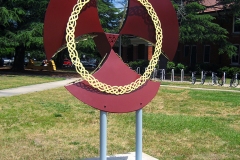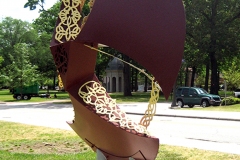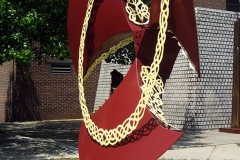Triquetra
7.5′ x 5′ x 3′
Steel
2011
Currently Avilable
Triquetra comes from the Latin words tri, meaning three and quetrus, meaning cornered. Triquetra is most commonly referred to as a Trefoil Knot or The Trinity Knot. This symbol is seen on Celtic Crosses and slab carvings from the 7th century to the 12th century. It is also frequently used in Insular Manuscripts such as the Book of Kells. Within the manuscripts pages it is primarily used as a filler of space and does not appear to have a symbolic function or meaning. During the Celtic Revival of the 19th century, the Triquetra, seen as a connection to the shamrock and St. Patrick, began to represent the Blessed Trinity of the Christian Religion (the Father, the Son, and the Holy Spirit). It began to appear as a dominate Christian symbol on sculpture, vestments, books, and church windows. Many Modern Pagans see the Triquetra as a symbol representing the three stages of the Triple Goddess: (the Maiden, the Mother, and the Crone), The Three Realms: (Earth, Sky and Sea), the interconnected parts of each of us: (the Mind, the Body, and the Soul), or of life itself: (Life, Death, and Rebirth). As a cultural symbol it has become a symbol of the three promises of a relationship, (Love, Honour, and Protect). It is commonly attached to the hands of the Claddagh ring, the traditional ring given for friendship, engagement, and marriage. Many Triquetra are also accompanied by a circle which has been read as the eternity of God’s love or the eternal circle of life. It can also represent the ancient circles of protection. Today, the Triquetra has become a symbol of the Celtic people and the Celtic lands. It is present on everything and anything that a tourist might buy and is one of the most recognized Interlace knots outside of Ireland.
This work takes the recognized symbol of the Triquetra and pairs it with other Interlace Knotwork to announce my heritage and my culture. But in this work, the Triquetra is only created through the negative space. To see the Trifoil Knot, one must look at what is not present, at what is missing. This piece is created to show that no matter how much I try to connect with my past, there will always be a piece that is missing.




